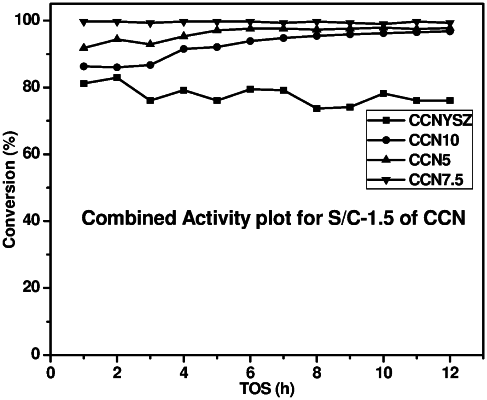| CPC B01J 23/866 (2013.01) [C01B 3/40 (2013.01); B01J 37/036 (2013.01); B01J 37/08 (2013.01); C01B 2203/0233 (2013.01); C01B 2203/0238 (2013.01); C01B 2203/1047 (2013.01)] | 6 Claims |

|
1. A process for preparation of a catalyst composition consisting of metal oxides of Ce, Cr and Ni, said process consisting of:
a. dissolving nitrate precursors consisting of Cr, Ce and Ni in a solvent to obtain a solution of metal nitrate precursors;
b. dissolving citric acid in the solvent to obtain a solution of citric acid, wherein citric acid is taken in 3:1 molar ratio of the solution of metal nitrate precursors of step (a);
c. adding the solution of metal nitrate precursors of step (a) into the solution of citric acid of step (b) followed by heating at a temperature ranging from 100° C. to 190° C. until evaporation of the solvent to form a gel; and
d. keeping the gel of step (c) in an oven at a temperature ranging from 100° C. to 190° C. for 24 to 25 hours to form a catalyst material followed by crushing the catalyst material to form a powder; and
e. keeping the powder in a furnace at 800° C. to obtain the catalyst composition,
wherein the nitrate precursors consists of chromium nitrate, cerium nitrate, and nickel nitrate, and
wherein the process is carried out in absence of noble metals.
|